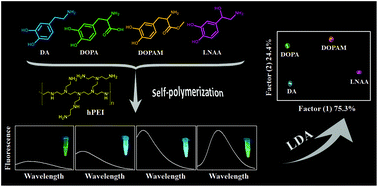Fluorescent sensor array for separation-free dopamine analogue discrimination via polyethyleneimine-mediated self-polymerization reaction†
Abstract
The effective discrimination of dopamine (DA) analogues is an enduring challenge because of their very tiny structural differences, and thus a separation technique is generally required during the conventional analysis. In this study, a hyperbranched polyethyleneimine (hPEI)-based fluorescent sensor array has been constructed for the separation-free and effective differentiation of four DA analogues. The discrimination includes two steps: firstly, the formation of fluorescent polymer nanoparticles (FPNs) with diverse emission profiles via hPEI-mediated self-polymerization reaction of DA analogues and secondly, the linear discriminant analysis of fluorescence patterns of the formed FPNs for the differentiation of DA analogues. The hPEI-assisted self-polymerization reaction of DA analogues and substitution group mediated optical properties of the resulted FPNs enable an excellent discrimination of four DA analogues at a concentration of 1.0 μM when linear discriminant analysis and hierarchical cluster analysis are smartly combined. Additionally, binary, tertiary and even quaternary mixtures of analogues can also be well distinguished with the proposed sensor array. The practicability of this established sensor array is validated by a high accuracy (100%) evaluation of 88 blind samples containing a single analogue or a mixture of two, three or four analogues.



 Please wait while we load your content...
Please wait while we load your content...